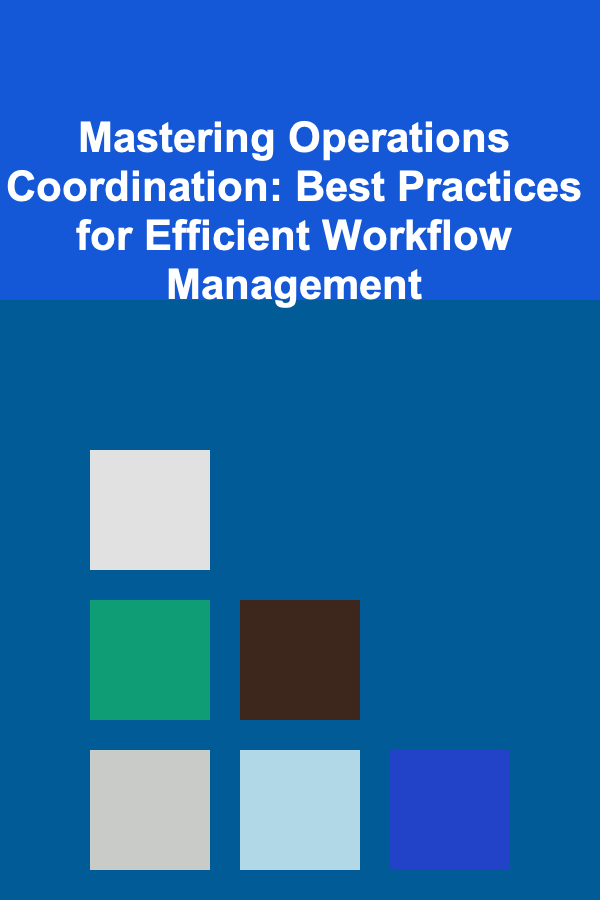
How to Start a Side Hustle to Boost Your Income
ebook include PDF & Audio bundle (Micro Guide)
$12.99$5.99
Limited Time Offer! Order within the next:

In today's rapidly changing economy, many people are turning to side hustles to boost their income and build financial security. Whether you're looking to pay off debt, save for a big purchase, or simply increase your disposable income, starting a side hustle can provide a much-needed financial cushion. But how exactly do you start a side hustle? What are the key steps, and how can you ensure its success?
Starting a side hustle requires careful planning, time management, and an entrepreneurial mindset. But with the right approach, it can be an incredibly rewarding and profitable endeavor. In this article, we will explore the various aspects of starting a side hustle, from identifying opportunities to managing your time effectively and ensuring long-term success.
Why Start a Side Hustle?
Before delving into the specifics of starting a side hustle, it's important to understand why you might want to take on this additional responsibility. Some of the most common reasons people start side hustles include:
1. Boosting Income
The most obvious reason for starting a side hustle is to increase your income. Whether you're working a full-time job and looking to supplement your earnings or you need to make ends meet due to unexpected expenses, a side hustle can help you generate extra cash flow. In many cases, side hustles can become a significant income source, potentially outpacing your primary job over time.
2. Pursuing Passions and Interests
Many people start side hustles because they want to explore a passion or interest that they might not be able to pursue in their full-time job. Whether it's photography, writing, or selling handmade crafts, side hustles allow you to turn hobbies into income streams while doing something you love.
3. Building Skills and Experience
Side hustles are also a great way to build new skills and gain experience in areas that interest you. This can be especially valuable if you're considering a career change or simply want to diversify your skill set. For instance, freelance writing, digital marketing, or graphic design can all be learned and practiced through side hustles, providing you with valuable skills that can enhance your resume.
4. Achieving Financial Goals
Whether your goal is to pay off student loans, save for a down payment on a house, or create an emergency fund, side hustles can help you achieve these financial objectives faster. By supplementing your primary income with side hustle earnings, you can make significant strides toward your financial goals in a shorter amount of time.
5. Gaining Financial Independence
For some, the ultimate goal of starting a side hustle is to gain financial independence. By creating additional streams of income, you can reduce your reliance on your primary job and work toward achieving greater financial freedom. Over time, some side hustles can grow into full-time businesses that allow you to become your own boss.
Step-by-Step Guide to Starting a Side Hustle
Now that we've established why starting a side hustle is worth considering, let's take a closer look at the practical steps involved in launching and growing your side hustle.
1. Identify Your Skills, Interests, and Market Opportunities
The first step in starting a side hustle is to identify your skills, interests, and the market opportunities available. Ask yourself questions like:
- What are you good at?
- What do you enjoy doing in your free time?
- Are there any problems in your life or the lives of others that need solving?
Your side hustle should align with your skills and passions, as this will make the work more enjoyable and sustainable in the long run. Moreover, it's important to research whether there is demand for your chosen product or service. If you enjoy photography but there's no demand for your photography services in your area, it may not be the best side hustle. However, if you have a knack for social media marketing and many businesses need help with online presence, this could be a lucrative avenue.
2. Choose a Side Hustle Idea
Once you've assessed your skills and interests, it's time to narrow down your options and choose a side hustle that fits. Here are some popular side hustle ideas:
- Freelancing: If you have expertise in writing, graphic design, web development, marketing, or consulting, freelancing platforms such as Upwork, Fiverr, and Freelancer offer a variety of opportunities to find clients and work on projects that fit your skill set.
- Online Tutoring or Teaching: If you're knowledgeable in a subject, you can offer tutoring services or teach online. Platforms like VIPKid, Chegg Tutors, or Skillshare allow you to create and sell online courses.
- E-commerce: If you're entrepreneurial, you can start an online store through platforms like Etsy, eBay, or Shopify. You could sell physical goods, handmade crafts, or even dropshipping products.
- Affiliate Marketing: If you have a blog or social media following, affiliate marketing can be a great way to earn passive income by promoting products or services and earning commissions on sales generated through your referral links.
- Social Media Management: Many small businesses are in need of help managing their social media profiles. If you have experience in this area, you can offer services as a freelance social media manager.
- Virtual Assistant: As businesses increasingly move online, there is a growing demand for virtual assistants. This role typically involves handling administrative tasks, scheduling, email management, and customer service.
- Delivery or Ride-sharing: If you have a car and flexible hours, driving for companies like Uber, Lyft, or DoorDash is an easy way to earn extra money on the side.
- Content Creation: If you have a talent for creating videos, writing, or other forms of digital content, you can earn money by monetizing platforms like YouTube, TikTok, or blogging.
3. Set Realistic Goals
When starting a side hustle, it's essential to set clear and realistic goals. Think about how much extra income you want to generate each month and what kind of time commitment you're willing to make. Setting measurable goals will help you track progress and stay motivated.
For example, if you're starting a freelance writing business, you might set a goal of landing three clients within the first month and earning $500 in the first two months. Setting small, achievable goals will allow you to build momentum as you grow your side hustle.
4. Create a Business Plan
Even though a side hustle might start small, it's still important to treat it like a business. This means creating a plan that outlines your goals, target market, pricing strategy, and marketing approach. A business plan doesn't have to be complex; it's just a roadmap that helps you stay focused and organized.
For instance, if you plan to sell handmade jewelry on Etsy, your business plan might include:
- A description of your product (handmade necklaces)
- Your target market (women aged 25-40)
- Your pricing strategy (competitive with other sellers)
- How you'll market your products (social media ads, influencer partnerships)
By taking the time to map out your business plan, you'll set yourself up for success and avoid overlooking important aspects of running your side hustle.
5. Set Up Your Side Hustle Logistics
Once you've created your business plan, it's time to handle the logistics. This could include:
- Registering Your Business: Depending on your location and the nature of your side hustle, you might need to register your business or obtain a permit. This step is especially important if you're selling products or offering services that require specific licenses.
- Setting Up Payment Systems: If you're providing a service, you'll need to set up a way to receive payments. Popular platforms include PayPal, Venmo, or Stripe. For e-commerce businesses, you may need to set up a payment gateway on your website.
- Creating an Online Presence: No matter what type of side hustle you're starting, having an online presence is essential. This could mean creating a website, social media profiles, or listing your services on a platform like Upwork or Fiverr.
- Time Management: If you're juggling a full-time job and a side hustle, managing your time efficiently is crucial. Use time-blocking techniques to allocate specific hours each week for your side hustle and stay consistent in your efforts.
6. Market Your Side Hustle
Marketing is key to growing your side hustle. You can market your business through various channels:
- Social Media: Use platforms like Instagram, Facebook, Twitter, or LinkedIn to showcase your services and products. Share behind-the-scenes content, customer testimonials, and promotions to attract potential clients or customers.
- Paid Ads: Platforms like Google Ads and Facebook Ads allow you to target specific demographics and get your side hustle in front of a larger audience. Even a small ad budget can result in increased visibility and sales.
- Networking: Attend industry events, join online forums, or connect with like-minded individuals to build relationships and gain referrals. Networking is an invaluable tool for growing your side hustle.
7. Track Your Finances and Taxes
As you start earning money from your side hustle, it's important to track your finances. Keep records of all your earnings and expenses, as you'll need this information when filing taxes. Consider using accounting software like QuickBooks or FreshBooks to make the process easier.
Additionally, make sure to set aside money for taxes. In many cases, you'll be considered a self-employed individual, and you'll need to pay quarterly taxes. Setting aside a percentage of your earnings for taxes will ensure that you're prepared when it's time to file.
8. Scale and Optimize Your Side Hustle
Once your side hustle is up and running, it's time to think about scaling. This could involve:
- Hiring help (freelancers, assistants)
- Automating tasks (using tools to schedule social media posts, manage emails, etc.)
- Expanding your product or service offerings
- Increasing your marketing efforts
By continuously optimizing your side hustle, you can grow it into a more significant source of income or even transition it into a full-time business.
Conclusion
Starting a side hustle can be a powerful way to boost your income, explore your passions, and develop new skills. By following the steps outlined in this guide---identifying your skills, choosing a business idea, setting goals, creating a plan, and marketing your hustle---you can create a profitable side business that aligns with your personal goals.
Remember, success in a side hustle takes time, dedication, and a willingness to learn. Stay persistent, and you'll see the benefits of your hard work in both your finances and personal growth.

How to Clean Your Home When You Have Small Kids
Read More
How to Create a Photo Album for Pet Lovers
Read More
How to Organize Your Sewing Supplies for Creative Projects
Read More
How to Use Natural Elements in Your Holiday Decorations
Read More
Mastering Operations Coordination: Best Practices for Efficient Workflow Management
Read More
The Environmental Consultant's Playbook: Navigating Challenges in Sustainability
Read MoreOther Products

How to Clean Your Home When You Have Small Kids
Read More
How to Create a Photo Album for Pet Lovers
Read More
How to Organize Your Sewing Supplies for Creative Projects
Read More
How to Use Natural Elements in Your Holiday Decorations
Read More
Mastering Operations Coordination: Best Practices for Efficient Workflow Management
Read More